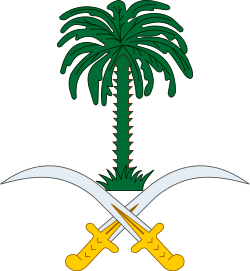Rabigh
| Miqat al-Juhfah al-Juhfah | |
|---|---|
|
Masjid Miqat al-Juhfah, Wadi Rabigh, Saudi Arabia | |
| Nickname(s): One of the Miqat | |
 Location of al Juhfah is ES. of Rabigh | |
| Country |
|
| Province | Rabigh,Saudi Arabia |
| Time zone | AST (UTC+3) |
Rabigh (Arabic: رابغ) is an ancient town on the western coast of Saudi Arabia, along the Red Sea in the Makkah Region.
History
Ubaydah's Expedition in Batn Rabigh
In April 623, the Islamic Prophet Muhammad sent Ubaydah ibn al-Harith with a party of sixty armed Muhajirun to the valley of Rabigh. They expected to intercept a Quraysh caravan that was returning from Syria under the protection of Abu Sufyan ibn Harb and 200 armed riders.[1][2][3][4][5] The Muslim party travelled as far as the wells at Thanyat al-Murra,[1][4] where Sa`d ibn Abi Waqqas shot an arrow at the Quraysh. This is known as the first arrow of Islam.[1][6][3] Despite this surprise attack, "they did not unsheathe a sword or approach one another," and the Muslims returned empty-handed.[2][3][4]
Hadith Ghadir Khumm and Hadith al-Thaqalayn
The hadith of the pond of Khumm narrates that the Prophet Muhammad is reported to have pronounced Ali ibn Abi Talib the mawla (patron, master) of those for whom Muhammad was patron.[7] Shia Muslims take and claim this hadith as an announcement and investiture of Ali bin Abi Talib as the first caliph or successor after the Prophet's death and they celebrate this announcement each year as Eid al-Ghadeer. Many Sunnis also accept that the Prophet did actually declare Ali as the mawla , however they refuse to believe that this meant succession to the Prophet. According to the Muwatta[8] by Malik ibn Anas, the oldest book in Islam after the Quran:
" 46.3 Yahya related to me from Malik that he heard that the Messenger of Allah, may Allah bless him and grant him peace, said, "I have left two things with you. As long as you hold fast to them, you will not go astray. They are the Book of Allah and the Sunna of His Prophet."[9]
According to Sunnis, there is no record of any disagreement between Muslim scholars concerning the alleged caliphate of Ali bin Abi Talib in the years proceeding the Prophet. Imam Jafar al-Sadiq whose views most Shias follow and Imam Abu Hanifa and Malik ibn Anas whose views most Sunnis follow worked together in Al-Masjid an-Nabawi in Medina. Along with Qasim ibn Muhammad ibn Abu Bakr, Muhammad al-Baqir, Zayd ibn Ali and over 70 other leading jurists and scholars. On the other hand, according to Shias, the dispute between Ali and the rest of the companions started right at the death of the Prophet when they abandoned him with the Prophet's dead body and quickly chose Abu Bakar as the caliph.[10] [11] [12] [13][14]
The Muwatta[8] by Malik ibn Anas was written as a consensus of the opinion of these scholars.[15][16][17] The Muwatta quotes 13 hadiths[8] from Imam Jafar al-Sadiq.[18] There had been oral transmission from generation to generation until then. The Muwatta[8] by Malik ibn Anas is the earliest of these books that is written solely to record the hadith.
See also
References
- E.J. Brill's First Encyclopaedia of Islam 1913-1936. BRILL. 1987. p. 134. ISBN 90-04-08265-4.
- 1 2 3 Ibn Ishaq/Guillaume, p. 281.
- 1 2 Ibn Saad/Bewley, p. 37.
- 1 2 3 Haykal, M. H. (1935). Translated by al-Faruqi, I. R. A. (1976). The Life of Muhammad, p. 256. Chicago: North American Trust Publications.
- 1 2 3 Mubarakpuri, S. R. (1979). Ar-Raheeq Al-Maktum (The Sealed Nectar), p. 92. Riyadh: Darussalem Publishers.
- ↑ Hawarey, Dr. Mosab (2010). The Journey of Prophecy; Days of Peace and War (Arabic). Islamic Book Trust. ISBN 9789957051648.Note: Book contains a list of battles of Muhammad in Arabic, English translation available here
- ↑ Sahih al-Bukhari, 5:57:74
- ↑ "Ghadir Khumm". oxfordislamicstudies.com.
- 1 2 3 4 "Muwatta". virtualave.net.
- ↑ "Muw18". virtualave.net.
- ↑ Hasyim, Syafiq (2006). Understanding Women in Islam An Indonesian Perspective. Equinox Publishing. p. 67. ISBN 978-979-3780-19-1.
- ↑ Norman Calder; Jawid Ahmad Mojaddedi; Andrew Rippin (2003). Classical Islam A Sourcebook of Religious Literature. Psychology Press. p. 37. ISBN 978-0-415-24032-1.
- ↑ Jonathan E. Brockopp; Jacob Neusner; Tamara Sonn (2005). Judaism and Islam in Practice A Sourcebook. Routledge. p. 101. ISBN 978-1-134-60553-8.
- ↑ Ja'far al-Sadiq on oocities.org
- ↑ Ja'far al-Sadiq on ziaraat.org
- ↑ Noel James Coulson (1964). A History of Islamic Law. Edinburgh University Press. p. 103. ISBN 978-0-7486-0514-9.
- ↑ M. Th. Houtsma (1993). E.J. Brill's First Encyclopaedia of Islam, 1913-1936. BRILL. p. 207. ISBN 90-04-09791-0.
- ↑ Šārôn, Moše (1986). Studies in Islamic History and Civilization In Honour of Professor David Ayalon. BRILL. p. 264. ISBN 965-264-014-X.
- ↑ Al-Muwatta of Imam Malik Ibn Anas:Translated by Aisha Bewley (Book #5, Hadith #5.9.23)(Book #16, Hadith #16.1.1)(Book #17, Hadith #17.24.43)(Book #20, Hadith #20.10.40)(Book #20, Hadith #20.11.44)(Book #20, Hadith #20.32.108)(Book #20, Hadith #20.39.127)(Book #20, Hadith #20.40.132)(Book #20, Hadith #20.49.167) (Book #20, Hadith #20.57.190)(Book #26, Hadith #26.1.2)(Book #29, Hadith #29.5.17)(Book #36, Hadith #36.4.5)
External links
Coordinates: 22°48′N 39°02′E / 22.800°N 39.033°E

